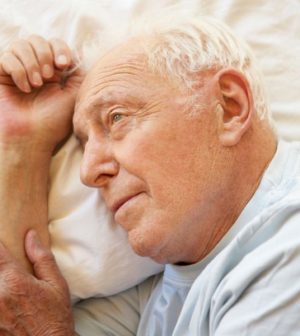- Navigating Your Midlife Crisis: Embracing New Possibilities
- City Raccoons Showing Signs of Domestication
- Mapping the Exposome: Science Broadens Focus to Environmental Disease Triggers
- One Week Less on Social Media Linked to Better Mental Health
- Your Brain Changes in Stages as You Age, Study Finds
- Some Suicide Victims Show No Typical Warning Signs, Study Finds
- ByHeart Formula Faces Lawsuits After Babies Sickened With Botulism
- Switch to Vegan Diet Could Cut Your Greenhouse Gas Emissions in Half
- Regular Bedtime Does Wonders for Blood Pressure
- Dining Alone Could Mean Worse Nutrition for Seniors
Nerve ‘Zap’ Treatment Could Be Alternative to CPAP for Sleep Apnea

People with more serious cases of sleep apnea may get lasting relief from an implanted nerve stimulator, a new study finds.
One specialist says the device might benefit those who can’t tolerate the current standard treatment for sleep apnea: continuous positive airway pressure (CPAP). CPAP involves wearing a mask over the nose and/or mouth every night, and many people balk at that.
The new device, called Inspire, works by sending electrical impulses to a nerve that controls the muscles of the tongue. When the stimulator is turned on before a person goes to sleep, it causes the tongue to protrude forward, which helps keep the airways open.
Inspire was approved in the United States in 2014, after a trial showed it was safe and effective over one year.
The new study followed 65 of those patients to the five-year mark, and found they were mostly still doing well.
On average, researchers found, the patients’ ratings of their sleepiness and quality of life had “normalized.” And they were still having far fewer apnea episodes — pauses in breathing during sleep.
“This shows the improvements are durable,” said researcher Dr. B. Tucker Woodson, an otolaryngologist and sleep specialist at the Medical College of Wisconsin.
Obstructive sleep apnea is a disorder in which the muscles of the throat fail to keep the airways open during sleep. That results in repeated interruptions in breathing — along with symptoms like loud snoring and daytime grogginess due to poor sleep.
The disorder is common, affecting more than 18 million U.S. adults, according to the National Sleep Foundation.
Sleep apnea can be effectively treated with CPAP, but many patients won’t try it.
“About one-third of patients look at it and walk away,” said Dr. Kathleen Yaremchuk, a sleep specialist who was not involved in the study.
Still others try CPAP but do not manage to use it consistently, said Yaremchuk, who is chair of otolaryngology at the Henry Ford Health System in Detroit.
The mask doesn’t always fit well, she explained, and there’s the inconvenience of having to travel with it and clean it.
So, Yaremchuk said, nerve stimulation offers a potential alternative for at least some patients.
The Inspire device has a few components, according to Minneapolis-based manufacturer Inspire Medical, which funded the current study. The pulse generator, which is implanted in the chest, has two wires. One senses the person’s breathing patterns; the other, which runs through the neck, stimulates the hypoglossal nerve when needed. The hypoglossal nerve controls tongue movements.
The device is turned on and off daily via remote control.
According to Yaremchuk, the new findings help answer a couple of questions.
For one, she said, it seems that people will keep using the stimulator over the years.
Plus, Yaremchuk said, it appears the device remains effective without having to up the voltage over time, which, in theory, could make it less comfortable to use.
At the end of the five-year follow-up, Woodson’s team found, patients were typically having about seven apnea episodes an hour each night — down from 29 before the device was implanted. And 89 percent were no longer snoring, or only “softly” snoring, versus 42 percent before.
The therapy is not perfect, Woodson said. A couple of patients in the original trial needed to have the device repositioned because of discomfort. Others had temporary numbness of the tongue, while 21 percent complained of tongue soreness.
The approach is only for certain patients, Yaremchuk said, not a “first-line” option.
Officially, the device is approved for people with moderate to severe sleep apnea who either do not find relief with CPAP or cannot tolerate it. It’s also intended for patients with a body mass index of less than 32 — which excludes many obese people.
That’s because the device stimulation is not strong enough for larger bodies, Yaremchuk explained.
Patients need a full evaluation to know whether the implant is a good option. And only specialized sleep centers offer it now, Woodson said.
Then there’s the cost; the device alone is around $20,000. Because it’s a fairly new therapy, insurers are only approving it on a case-by-case basis, according to Inspire Medical.
The estimated battery life of the generator is 11 years, Woodson said, so it will need to be replaced near that time.
The findings were to be reported at this week’s annual meeting of the American Academy of Otolaryngology – Head & Neck Surgery, in Chicago. Data and conclusions presented at medical meetings are usually considered preliminary until published in a peer-reviewed medical journal.
More information
The National Sleep Foundation has more on sleep apnea treatment.
Source: HealthDay
Copyright © 2025 HealthDay. All rights reserved.










